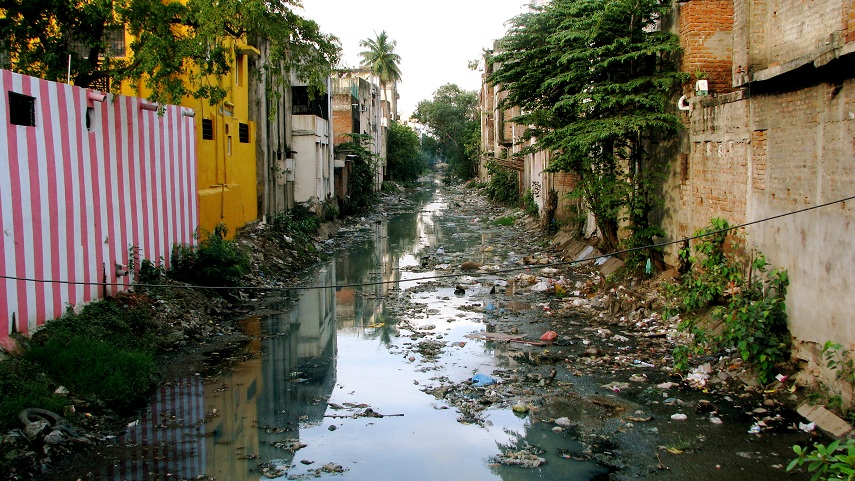Cooum, the sewage river of Chennai, saw a more or less cleansed state in November 2015 after the Chennai floods. It was a much needed sparkling picture, after years and years of watching Cooum get polluted. When one could not even go near the river without holding his/her nose, it was astonishing to see a clean Cooum. What the government had been doing in order to clean up the river for years, the rain did it in just a few days.
However, the clean state of Cooum was very brief. It was not long, after which it started getting uglier again. So this leads us to the question, why can’t Cooum stay clean for a longer time? What really happens to our city’s poop? Are they both somehow correlated to each other? In an Analysis by The News Minute, the entire process of Chennai’s sewage treatment has been explained in detail:
Flushed down the toilet:
It may be the end for your constipation issues, but the journey has just started for your poop once it gets flushed. The poop gets carried down into the sewers to the nearest manhole available. Manholes are available every 100 ft in Chennai and it can hold varying amounts of sewage. The volume that can be held depends on the area and the population there; an area with an apartment will have manholes with a larger capacity.
From the manholes, the poop gets carried through sewer lines to sewage pumping stations. In Chennai, there are 250 sewage pumping stations available.
Sewage Pumping Stations:
The poop from your homes gets carried to the nearest available sewage pumping stations. These stations are the lowest points of the area and follow a system depending on gravity. The poop undergoes a 24-hour process of collection, screening, and suction.
The sewage gets collected in the collection well and then goes to the screening well to separate the solid waste from the liquid. The sewage liquid is then removed by suction methods and is carried to sewage treatment plants.
Sewage Treatment Plants:
The sewage treatment plant or the STP is where chemical reactions are taken place. The smaller solid particles are made to settle down by centrifugation. Most of the STPs convert the solid waste that settles down into methane gas by means of sludge digesters. The methane gas produced is used as an energy source for the treatment plants. Other STPs store the sludge residue within the plant itself.
Chennai is separated into five zones- Kodungaiyur (1, 2), Koyambedu (3), Nesapakkam (4) and Perungudi (5). Each zone has 3 STPs and so in total, Chennai has 12 STPs.
Treated water:
The water that is left behind gets treated with chlorine and is then released into the water bodies of Chennai- Cooum, the Buckingham Canal, and the Adyar River. It is fully taken care to ensure that the released water does not disrupt the water bodies.
Holes in the sewage system:
Even though the sewage disposal process of Chennai sounds posh, it is actually not so. Many areas in the city do not have proper sewage systems and rely on septic tanks. The waste of each house gets collected in individual septic tanks which get carried to treatment plants in sewage tankers. The use of septic tanks is a very ancient method and is sometimes gets really messy.
The CMWSSB took control of water supply and sewerage services from the Corporation of Madras to exclusively take care of the growing needs for a well-established sewerage system. In the 1970s, the Board only had to take care of an area which extended to 176 sq km. However, in 2010 the Chennai Metropolitan Area increased to an alarming 425 sq. km. This made it difficult to handle all the waste.
It is very disturbing to know that out of the 15 areas of Chennai, only 8 of it have proper functioning sewerage systems. It is even more shocking to find out that only one-third of the 1,800-2000 million litre of sewage that is being produced every day, gets treated. Very evidently, most of the poop from your houses just gets directly mixed into the water bodies which are a source of drinking water. Sometimes, due to the lack of a proper sewage system, the waste gets illegally drained through the storm water drains.
The final state:
The brutal truth is that sewage treatment plants do not have enough capacity to treat all the waste produced by the city. Thus a lot of the sewage material gets dumped into water bodies. This kind of dumping has been happening for almost 3600 different kinds of water bodies. “If at least 10 of our water bodies had been maintained properly, then we wouldn’t be facing the water crisis that we are today. The Korattur Lake, for instance, was handed over to Metrowater to use for drinking purposes. But the contamination of sewage in it rendered it useless for the purpose,” says Jayaram Venkatesan of the Arappor Iyakkam.
The CMWSSB swears to have not been part of such actions though. According to the Board, the pitiable state of Cooum lies solely on the residents near it. Poor sanitation and total disregard for the environment has led to this situation.

